air suspension FORD F-650/750 2018 Owners Manual
[x] Cancel search | Manufacturer: FORD, Model Year: 2018, Model line: F-650/750, Model: FORD F-650/750 2018Pages: 386, PDF Size: 9.01 MB
Page 6 of 386
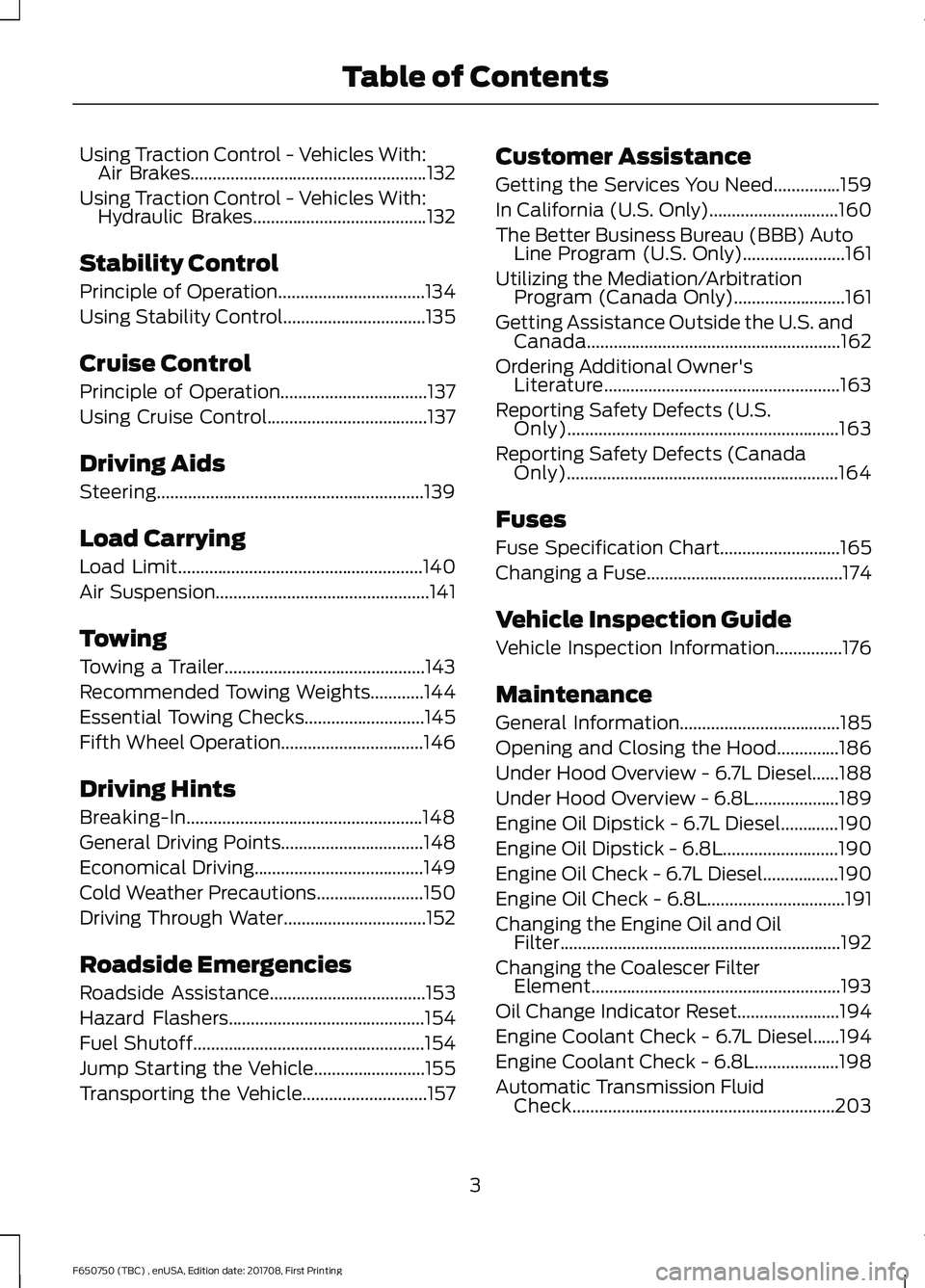
Using Traction Control - Vehicles With:
Air Brakes.....................................................132
Using Traction Control - Vehicles With: Hydraulic Brakes
.......................................132
Stability Control
Principle of Operation.................................134
Using Stability Control................................135
Cruise Control
Principle of Operation.................................137
Using Cruise Control....................................137
Driving Aids
Steering............................................................139
Load Carrying
Load Limit
.......................................................140
Air Suspension
................................................141
Towing
Towing a Trailer.............................................143
Recommended Towing Weights............144
Essential Towing Checks...........................145
Fifth Wheel Operation
................................146
Driving Hints
Breaking-In.....................................................148
General Driving Points
................................148
Economical Driving......................................149
Cold Weather Precautions........................150
Driving Through Water
................................152
Roadside Emergencies
Roadside Assistance
...................................153
Hazard Flashers
............................................154
Fuel Shutoff
....................................................154
Jump Starting the Vehicle.........................155
Transporting the Vehicle
............................157 Customer Assistance
Getting the Services You Need
...............159
In California (U.S. Only).............................160
The Better Business Bureau (BBB) Auto Line Program (U.S. Only).......................161
Utilizing the Mediation/Arbitration Program (Canada Only)
.........................161
Getting Assistance Outside the U.S. and Canada
.........................................................162
Ordering Additional Owner's Literature.....................................................163
Reporting Safety Defects (U.S. Only).............................................................163
Reporting Safety Defects (Canada Only).............................................................164
Fuses
Fuse Specification Chart...........................165
Changing a Fuse............................................174
Vehicle Inspection Guide
Vehicle Inspection Information...............176
Maintenance
General Information
....................................185
Opening and Closing the Hood..............186
Under Hood Overview - 6.7L Diesel......188
Under Hood Overview - 6.8L...................189
Engine Oil Dipstick - 6.7L Diesel.............190
Engine Oil Dipstick - 6.8L..........................190
Engine Oil Check - 6.7L Diesel.................190
Engine Oil Check - 6.8L
...............................191
Changing the Engine Oil and Oil Filter...............................................................192
Changing the Coalescer Filter Element........................................................193
Oil Change Indicator Reset.......................194
Engine Coolant Check - 6.7L Diesel......194
Engine Coolant Check - 6.8L...................198
Automatic Transmission Fluid Check...........................................................203
3
F650750 (TBC) , enUSA, Edition date: 201708, First Printing Table of Contents
Page 7 of 386
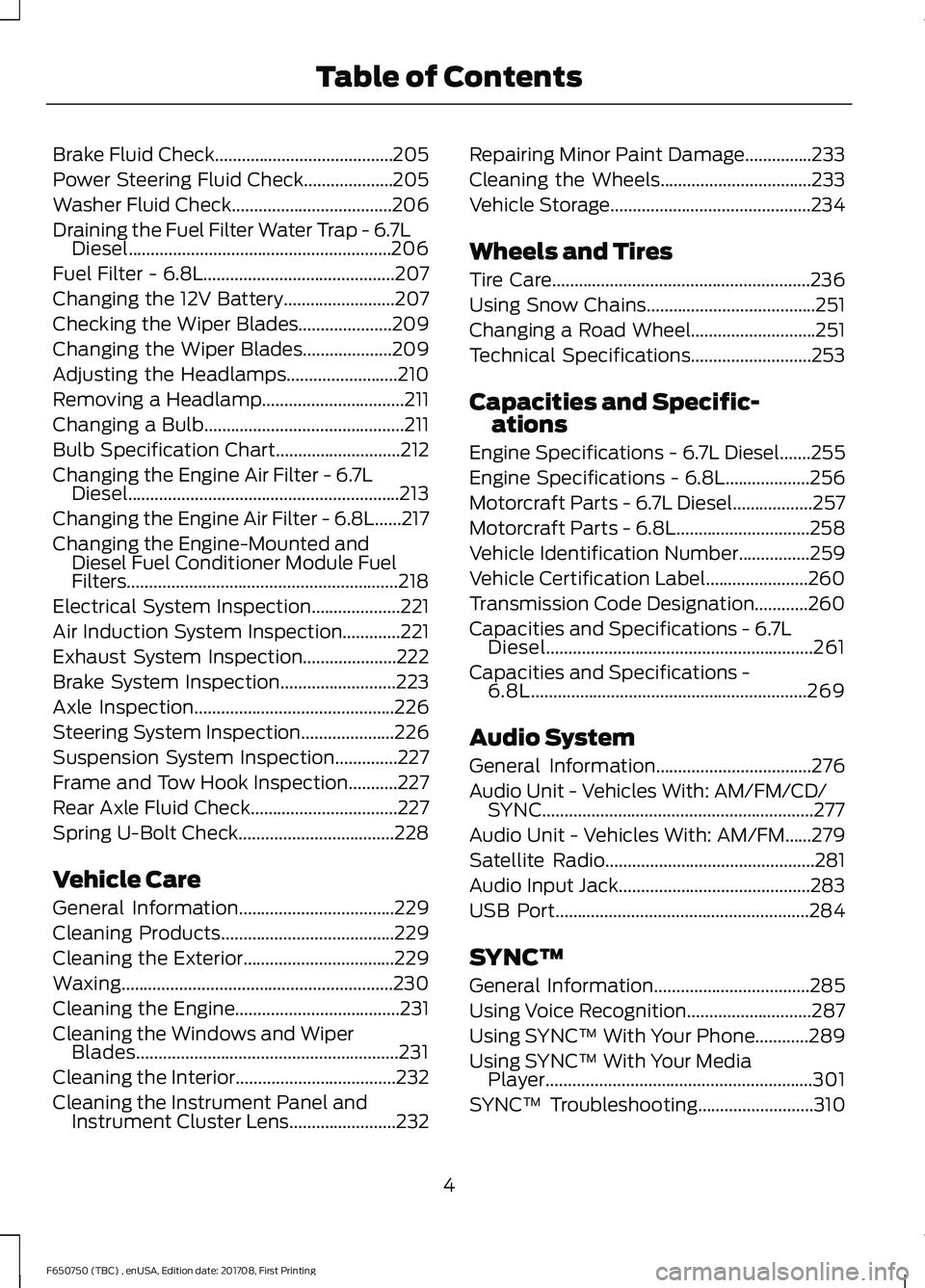
Brake Fluid Check........................................205
Power Steering Fluid Check....................205
Washer Fluid Check....................................206
Draining the Fuel Filter Water Trap - 6.7L Diesel...........................................................206
Fuel Filter - 6.8L...........................................207
Changing the 12V Battery.........................207
Checking the Wiper Blades.....................209
Changing the Wiper Blades....................209
Adjusting the Headlamps
.........................210
Removing a Headlamp................................211
Changing a Bulb
.............................................211
Bulb Specification Chart............................212
Changing the Engine Air Filter - 6.7L Diesel.............................................................213
Changing the Engine Air Filter - 6.8L......217
Changing the Engine-Mounted and Diesel Fuel Conditioner Module Fuel
Filters .............................................................
218
Electrical System Inspection....................221
Air Induction System Inspection.............221
Exhaust System Inspection.....................222
Brake System Inspection..........................223
Axle Inspection
.............................................226
Steering System Inspection.....................226
Suspension System Inspection
..............227
Frame and Tow Hook Inspection...........227
Rear Axle Fluid Check.................................227
Spring U-Bolt Check...................................228
Vehicle Care
General Information
...................................229
Cleaning Products
.......................................229
Cleaning the Exterior..................................229
Waxing.............................................................230
Cleaning the Engine.....................................231
Cleaning the Windows and Wiper Blades...........................................................231
Cleaning the Interior....................................232
Cleaning the Instrument Panel and Instrument Cluster Lens........................232 Repairing Minor Paint Damage
...............233
Cleaning the Wheels..................................233
Vehicle Storage
.............................................234
Wheels and Tires
Tire Care
..........................................................236
Using Snow Chains......................................251
Changing a Road Wheel............................251
Technical Specifications...........................253
Capacities and Specific- ations
Engine Specifications - 6.7L Diesel.......255
Engine Specifications - 6.8L
...................256
Motorcraft Parts - 6.7L Diesel..................257
Motorcraft Parts - 6.8L..............................258
Vehicle Identification Number
................259
Vehicle Certification Label.......................260
Transmission Code Designation............260
Capacities and Specifications - 6.7L Diesel............................................................261
Capacities and Specifications - 6.8L..............................................................269
Audio System
General Information
...................................276
Audio Unit - Vehicles With: AM/FM/CD/ SYNC.............................................................277
Audio Unit - Vehicles With: AM/FM
......279
Satellite Radio
...............................................281
Audio Input Jack...........................................283
USB Port
.........................................................284
SYNC™
General Information
...................................285
Using Voice Recognition............................287
Using SYNC™ With Your Phone............289
Using SYNC™ With Your Media Player............................................................301
SYNC™ Troubleshooting
..........................310
4
F650750 (TBC) , enUSA, Edition date: 201708, First Printing Table of Contents
Page 63 of 386
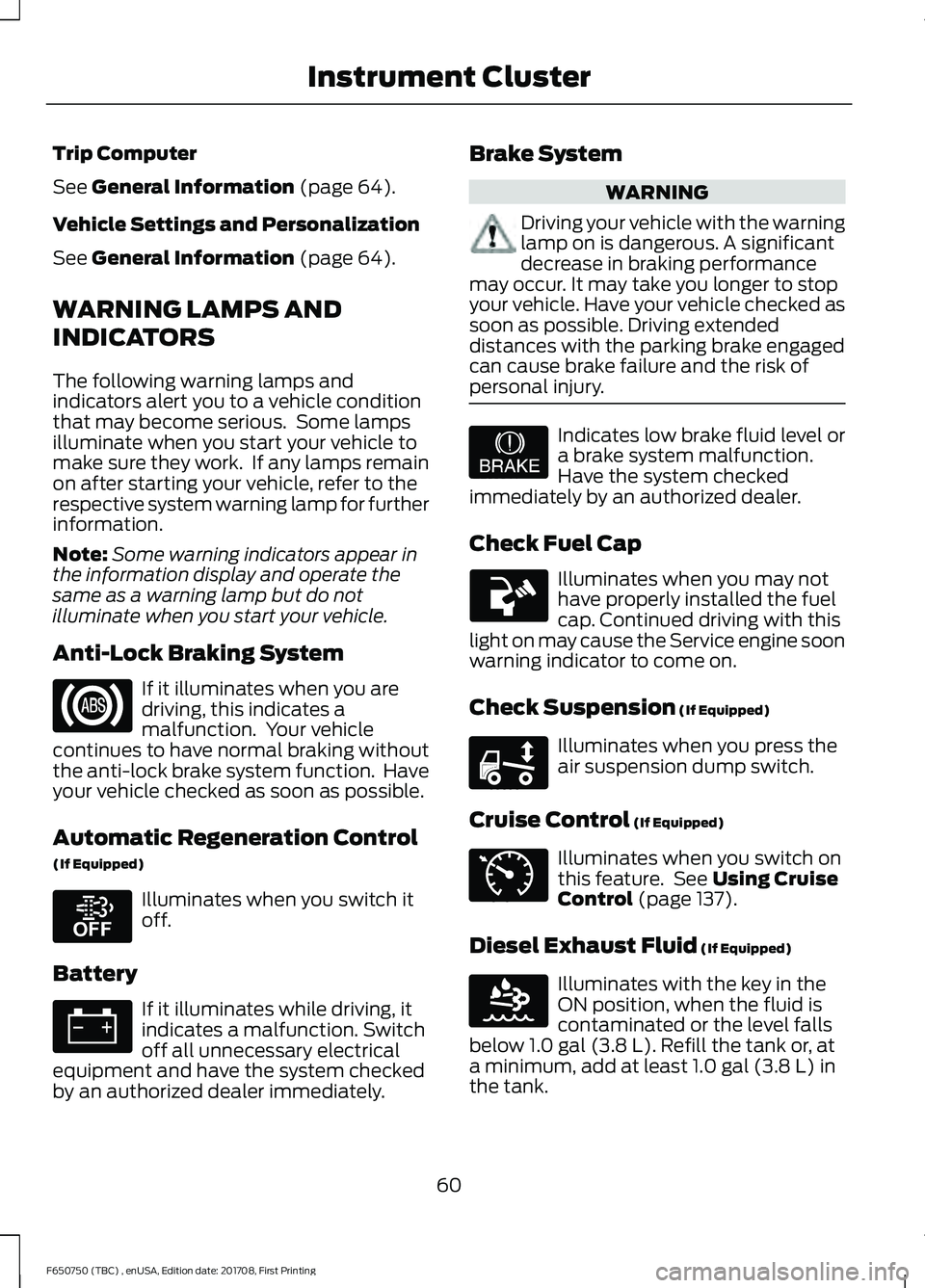
Trip Computer
See General Information (page 64).
Vehicle Settings and Personalization
See
General Information (page 64).
WARNING LAMPS AND
INDICATORS
The following warning lamps and
indicators alert you to a vehicle condition
that may become serious. Some lamps
illuminate when you start your vehicle to
make sure they work. If any lamps remain
on after starting your vehicle, refer to the
respective system warning lamp for further
information.
Note: Some warning indicators appear in
the information display and operate the
same as a warning lamp but do not
illuminate when you start your vehicle.
Anti-Lock Braking System If it illuminates when you are
driving, this indicates a
malfunction. Your vehicle
continues to have normal braking without
the anti-lock brake system function. Have
your vehicle checked as soon as possible.
Automatic Regeneration Control
(If Equipped) Illuminates when you switch it
off.
Battery If it illuminates while driving, it
indicates a malfunction. Switch
off all unnecessary electrical
equipment and have the system checked
by an authorized dealer immediately. Brake System WARNING
Driving your vehicle with the warning
lamp on is dangerous. A significant
decrease in braking performance
may occur. It may take you longer to stop
your vehicle. Have your vehicle checked as
soon as possible. Driving extended
distances with the parking brake engaged
can cause brake failure and the risk of
personal injury. Indicates low brake fluid level or
a brake system malfunction.
Have the system checked
immediately by an authorized dealer.
Check Fuel Cap Illuminates when you may not
have properly installed the fuel
cap. Continued driving with this
light on may cause the Service engine soon
warning indicator to come on.
Check Suspension
(If Equipped) Illuminates when you press the
air suspension dump switch.
Cruise Control
(If Equipped) Illuminates when you switch on
this feature. See
Using Cruise
Control (page 137).
Diesel Exhaust Fluid
(If Equipped) Illuminates with the key in the
ON position, when the fluid is
contaminated or the level falls
below
1.0 gal (3.8 L). Refill the tank or, at
a minimum, add at least 1.0 gal (3.8 L) in
the tank.
60
F650750 (TBC) , enUSA, Edition date: 201708, First Printing Instrument Cluster E208811 E209041 E208808 E71340 E163176
Page 137 of 386
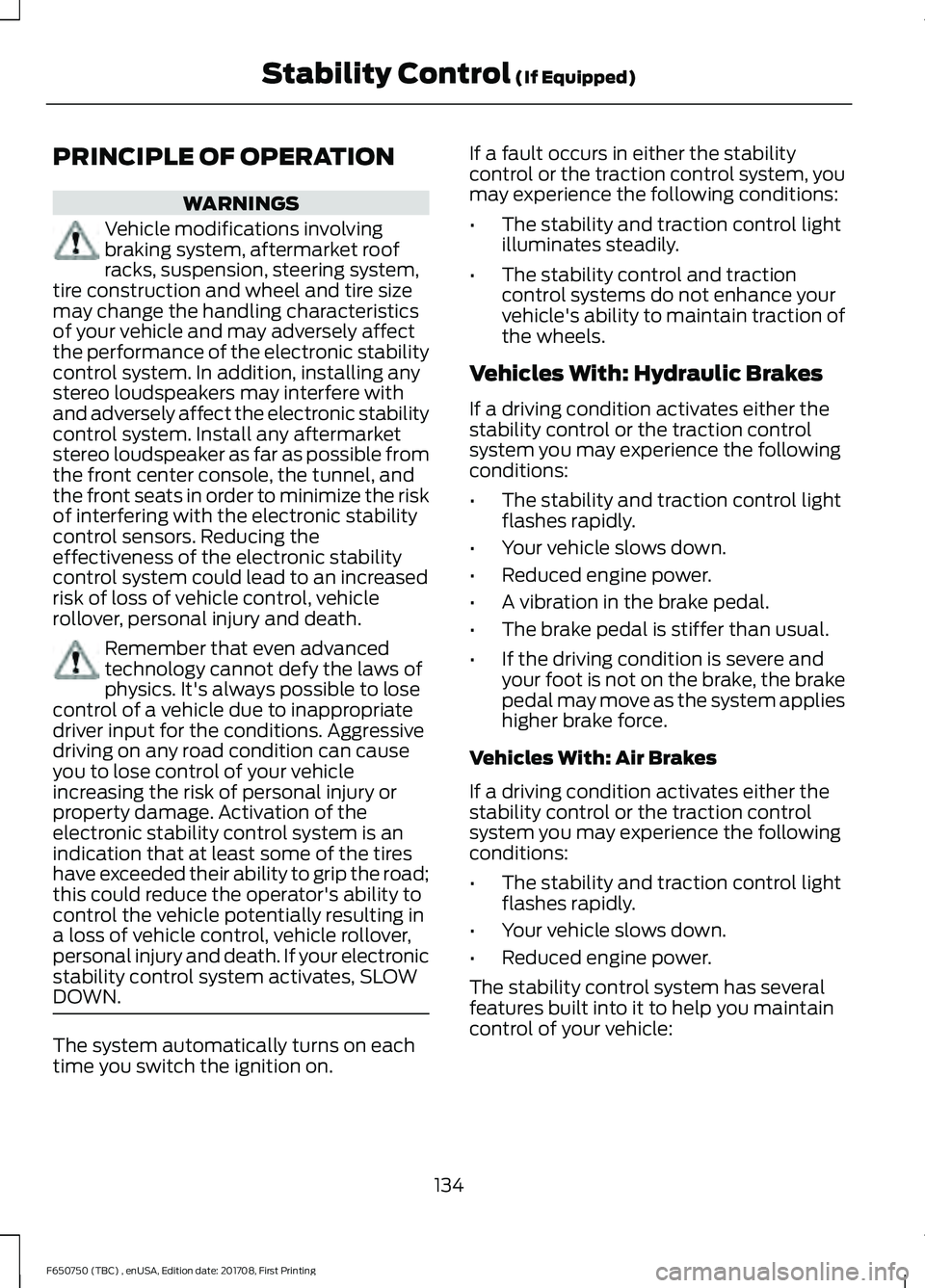
PRINCIPLE OF OPERATION
WARNINGS
Vehicle modifications involving
braking system, aftermarket roof
racks, suspension, steering system,
tire construction and wheel and tire size
may change the handling characteristics
of your vehicle and may adversely affect
the performance of the electronic stability
control system. In addition, installing any
stereo loudspeakers may interfere with
and adversely affect the electronic stability
control system. Install any aftermarket
stereo loudspeaker as far as possible from
the front center console, the tunnel, and
the front seats in order to minimize the risk
of interfering with the electronic stability
control sensors. Reducing the
effectiveness of the electronic stability
control system could lead to an increased
risk of loss of vehicle control, vehicle
rollover, personal injury and death. Remember that even advanced
technology cannot defy the laws of
physics. It's always possible to lose
control of a vehicle due to inappropriate
driver input for the conditions. Aggressive
driving on any road condition can cause
you to lose control of your vehicle
increasing the risk of personal injury or
property damage. Activation of the
electronic stability control system is an
indication that at least some of the tires
have exceeded their ability to grip the road;
this could reduce the operator's ability to
control the vehicle potentially resulting in
a loss of vehicle control, vehicle rollover,
personal injury and death. If your electronic
stability control system activates, SLOW
DOWN. The system automatically turns on each
time you switch the ignition on. If a fault occurs in either the stability
control or the traction control system, you
may experience the following conditions:
•
The stability and traction control light
illuminates steadily.
• The stability control and traction
control systems do not enhance your
vehicle's ability to maintain traction of
the wheels.
Vehicles With: Hydraulic Brakes
If a driving condition activates either the
stability control or the traction control
system you may experience the following
conditions:
• The stability and traction control light
flashes rapidly.
• Your vehicle slows down.
• Reduced engine power.
• A vibration in the brake pedal.
• The brake pedal is stiffer than usual.
• If the driving condition is severe and
your foot is not on the brake, the brake
pedal may move as the system applies
higher brake force.
Vehicles With: Air Brakes
If a driving condition activates either the
stability control or the traction control
system you may experience the following
conditions:
• The stability and traction control light
flashes rapidly.
• Your vehicle slows down.
• Reduced engine power.
The stability control system has several
features built into it to help you maintain
control of your vehicle:
134
F650750 (TBC) , enUSA, Edition date: 201708, First Printing Stability Control (If Equipped)
Page 139 of 386
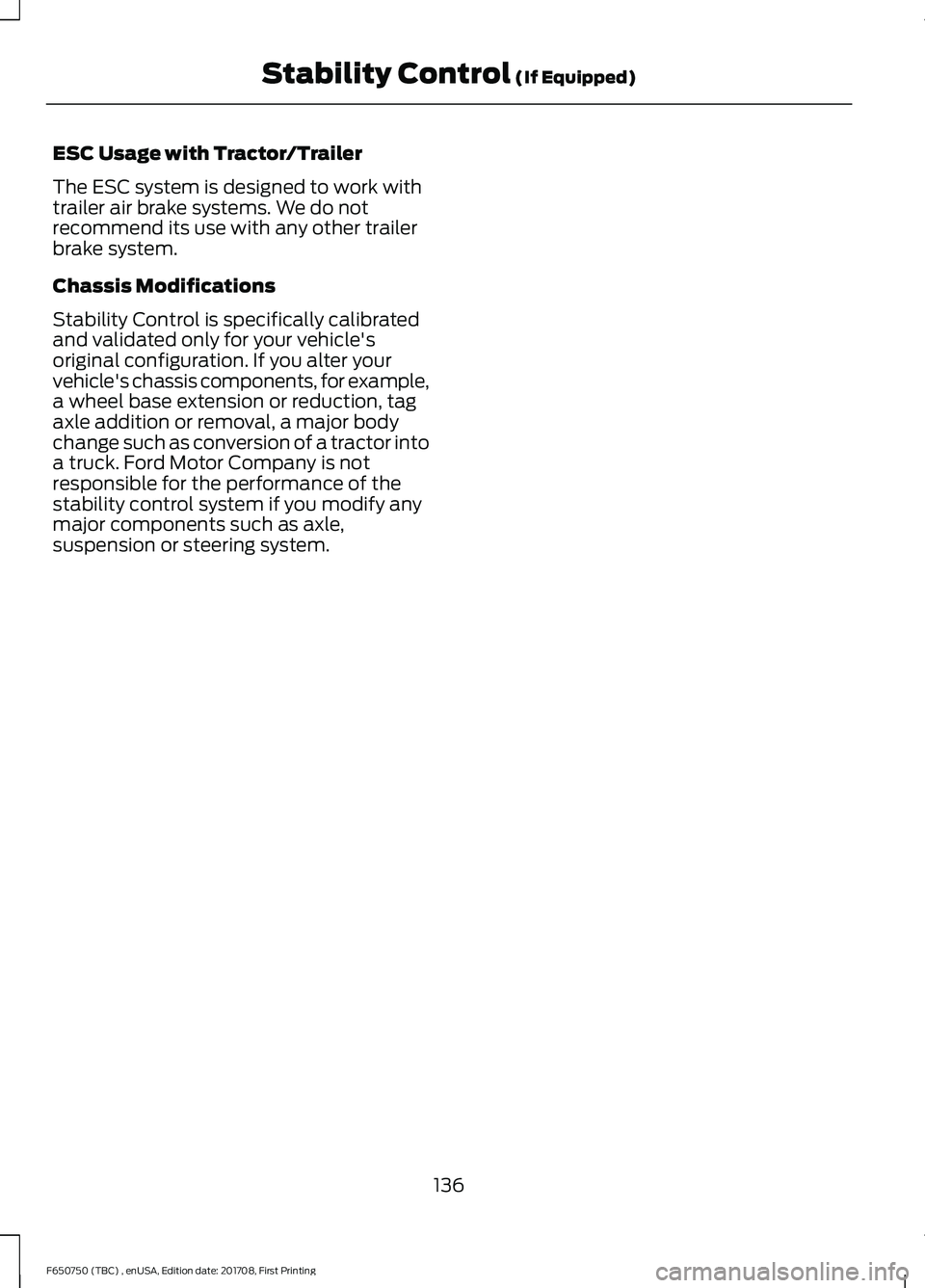
ESC Usage with Tractor/Trailer
The ESC system is designed to work with
trailer air brake systems. We do not
recommend its use with any other trailer
brake system.
Chassis Modifications
Stability Control is specifically calibrated
and validated only for your vehicle's
original configuration. If you alter your
vehicle's chassis components, for example,
a wheel base extension or reduction, tag
axle addition or removal, a major body
change such as conversion of a tractor into
a truck. Ford Motor Company is not
responsible for the performance of the
stability control system if you modify any
major components such as axle,
suspension or steering system.
136
F650750 (TBC) , enUSA, Edition date: 201708, First Printing Stability Control (If Equipped)
Page 144 of 386
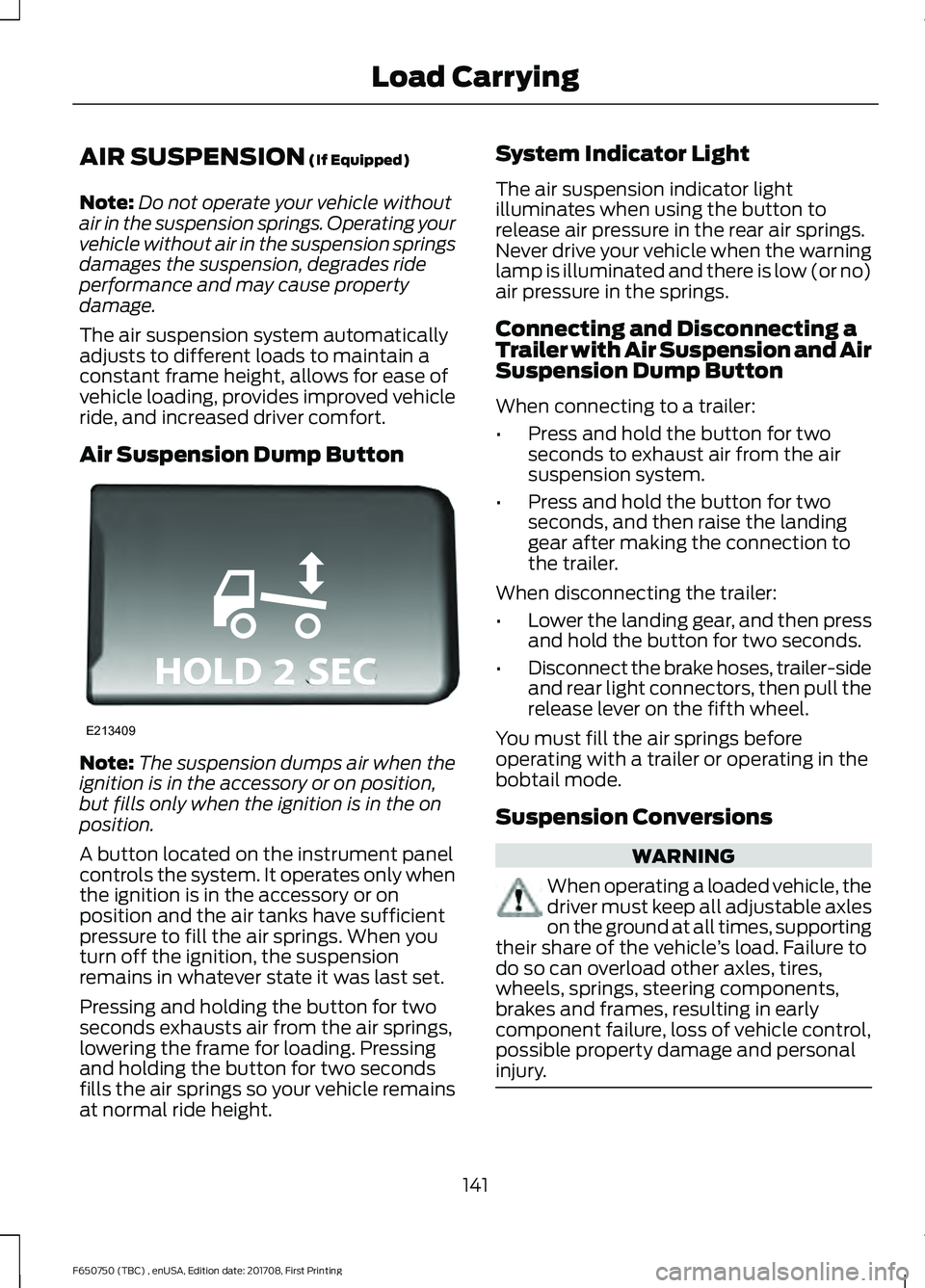
AIR SUSPENSION (If Equipped)
Note: Do not operate your vehicle without
air in the suspension springs. Operating your
vehicle without air in the suspension springs
damages the suspension, degrades ride
performance and may cause property
damage.
The air suspension system automatically
adjusts to different loads to maintain a
constant frame height, allows for ease of
vehicle loading, provides improved vehicle
ride, and increased driver comfort.
Air Suspension Dump Button Note:
The suspension dumps air when the
ignition is in the accessory or on position,
but fills only when the ignition is in the on
position.
A button located on the instrument panel
controls the system. It operates only when
the ignition is in the accessory or on
position and the air tanks have sufficient
pressure to fill the air springs. When you
turn off the ignition, the suspension
remains in whatever state it was last set.
Pressing and holding the button for two
seconds exhausts air from the air springs,
lowering the frame for loading. Pressing
and holding the button for two seconds
fills the air springs so your vehicle remains
at normal ride height. System Indicator Light
The air suspension indicator light
illuminates when using the button to
release air pressure in the rear air springs.
Never drive your vehicle when the warning
lamp is illuminated and there is low (or no)
air pressure in the springs.
Connecting and Disconnecting a
Trailer with Air Suspension and Air
Suspension Dump Button
When connecting to a trailer:
•
Press and hold the button for two
seconds to exhaust air from the air
suspension system.
• Press and hold the button for two
seconds, and then raise the landing
gear after making the connection to
the trailer.
When disconnecting the trailer:
• Lower the landing gear, and then press
and hold the button for two seconds.
• Disconnect the brake hoses, trailer-side
and rear light connectors, then pull the
release lever on the fifth wheel.
You must fill the air springs before
operating with a trailer or operating in the
bobtail mode.
Suspension Conversions WARNING
When operating a loaded vehicle, the
driver must keep all adjustable axles
on the ground at all times, supporting
their share of the vehicle ’s load. Failure to
do so can overload other axles, tires,
wheels, springs, steering components,
brakes and frames, resulting in early
component failure, loss of vehicle control,
possible property damage and personal
injury. 141
F650750 (TBC) , enUSA, Edition date: 201708, First Printing Load CarryingE213409
Page 145 of 386
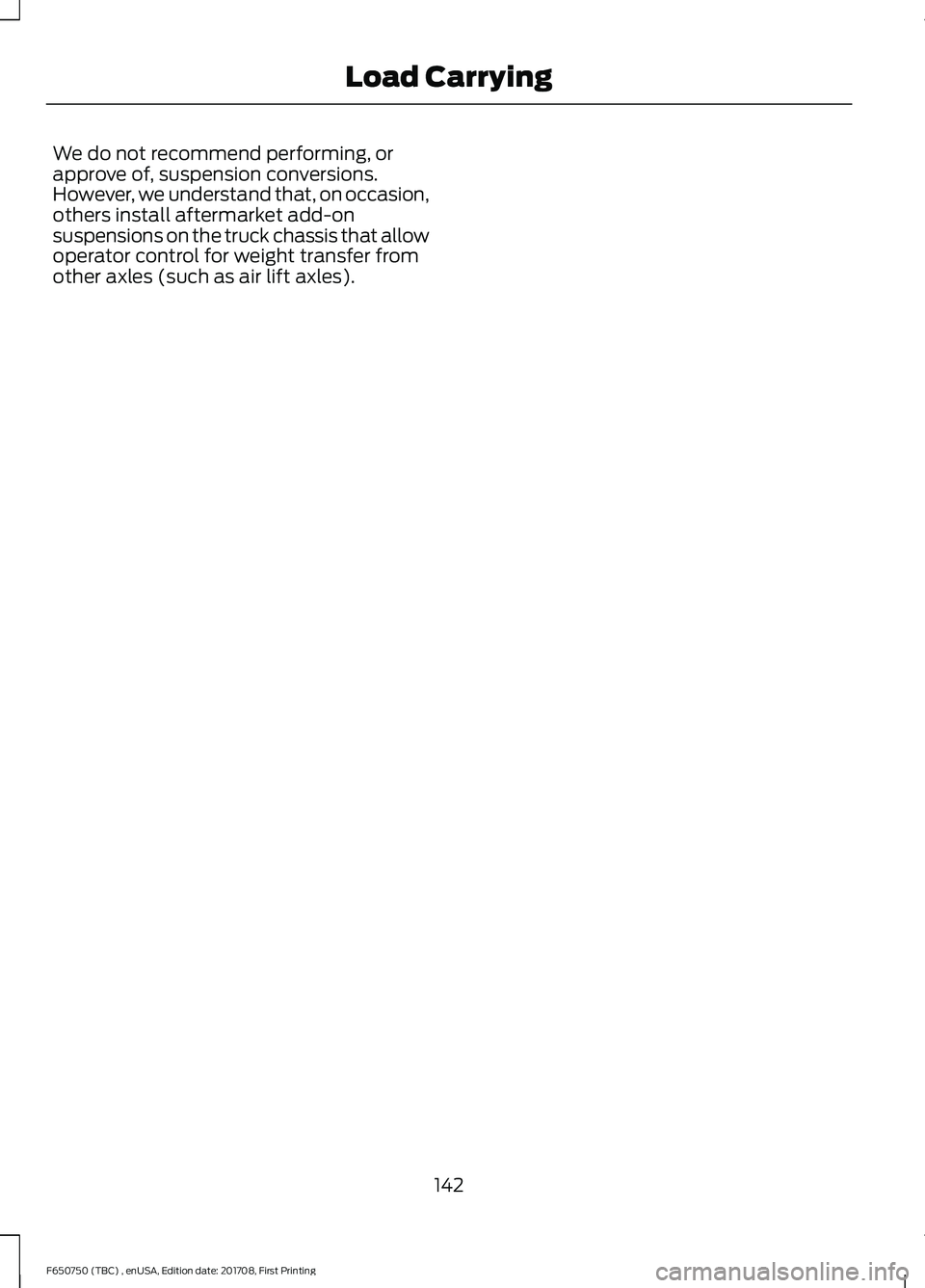
We do not recommend performing, or
approve of, suspension conversions.
However, we understand that, on occasion,
others install aftermarket add-on
suspensions on the truck chassis that allow
operator control for weight transfer from
other axles (such as air lift axles).
142
F650750 (TBC) , enUSA, Edition date: 201708, First Printing Load Carrying
Page 179 of 386
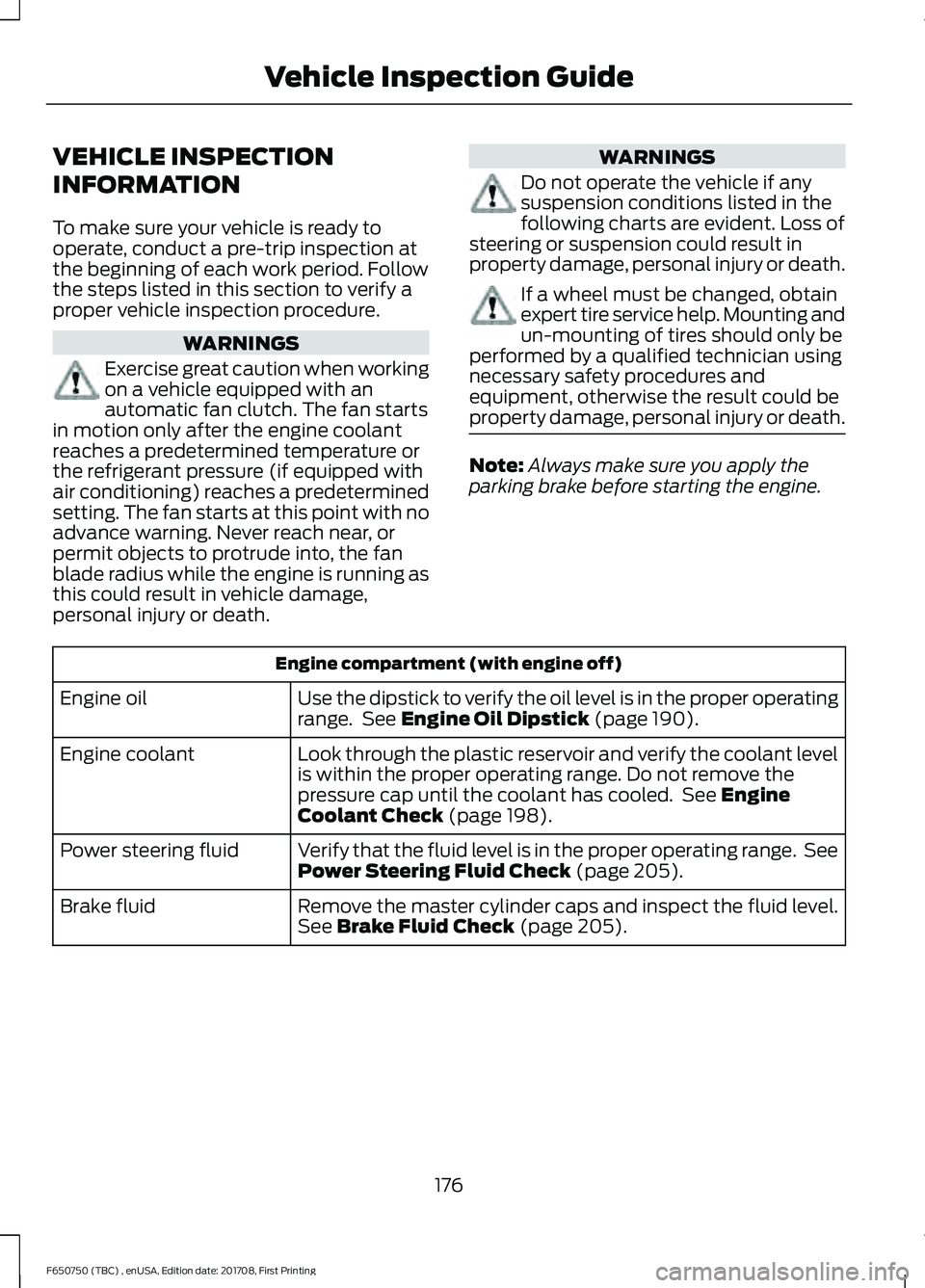
VEHICLE INSPECTION
INFORMATION
To make sure your vehicle is ready to
operate, conduct a pre-trip inspection at
the beginning of each work period. Follow
the steps listed in this section to verify a
proper vehicle inspection procedure.
WARNINGS
Exercise great caution when working
on a vehicle equipped with an
automatic fan clutch. The fan starts
in motion only after the engine coolant
reaches a predetermined temperature or
the refrigerant pressure (if equipped with
air conditioning) reaches a predetermined
setting. The fan starts at this point with no
advance warning. Never reach near, or
permit objects to protrude into, the fan
blade radius while the engine is running as
this could result in vehicle damage,
personal injury or death. WARNINGS
Do not operate the vehicle if any
suspension conditions listed in the
following charts are evident. Loss of
steering or suspension could result in
property damage, personal injury or death. If a wheel must be changed, obtain
expert tire service help. Mounting and
un-mounting of tires should only be
performed by a qualified technician using
necessary safety procedures and
equipment, otherwise the result could be
property damage, personal injury or death. Note:
Always make sure you apply the
parking brake before starting the engine. Engine compartment (with engine off)
Use the dipstick to verify the oil level is in the proper operating
range. See Engine Oil Dipstick (page 190).
Engine oil
Look through the plastic reservoir and verify the coolant level
is within the proper operating range. Do not remove the
pressure cap until the coolant has cooled. See
Engine
Coolant Check (page 198).
Engine coolant
Verify that the fluid level is in the proper operating range. See
Power Steering Fluid Check
(page 205).
Power steering fluid
Remove the master cylinder caps and inspect the fluid level.
See
Brake Fluid Check (page 205).
Brake fluid
176
F650750 (TBC) , enUSA, Edition date: 201708, First Printing Vehicle Inspection Guide
Page 185 of 386
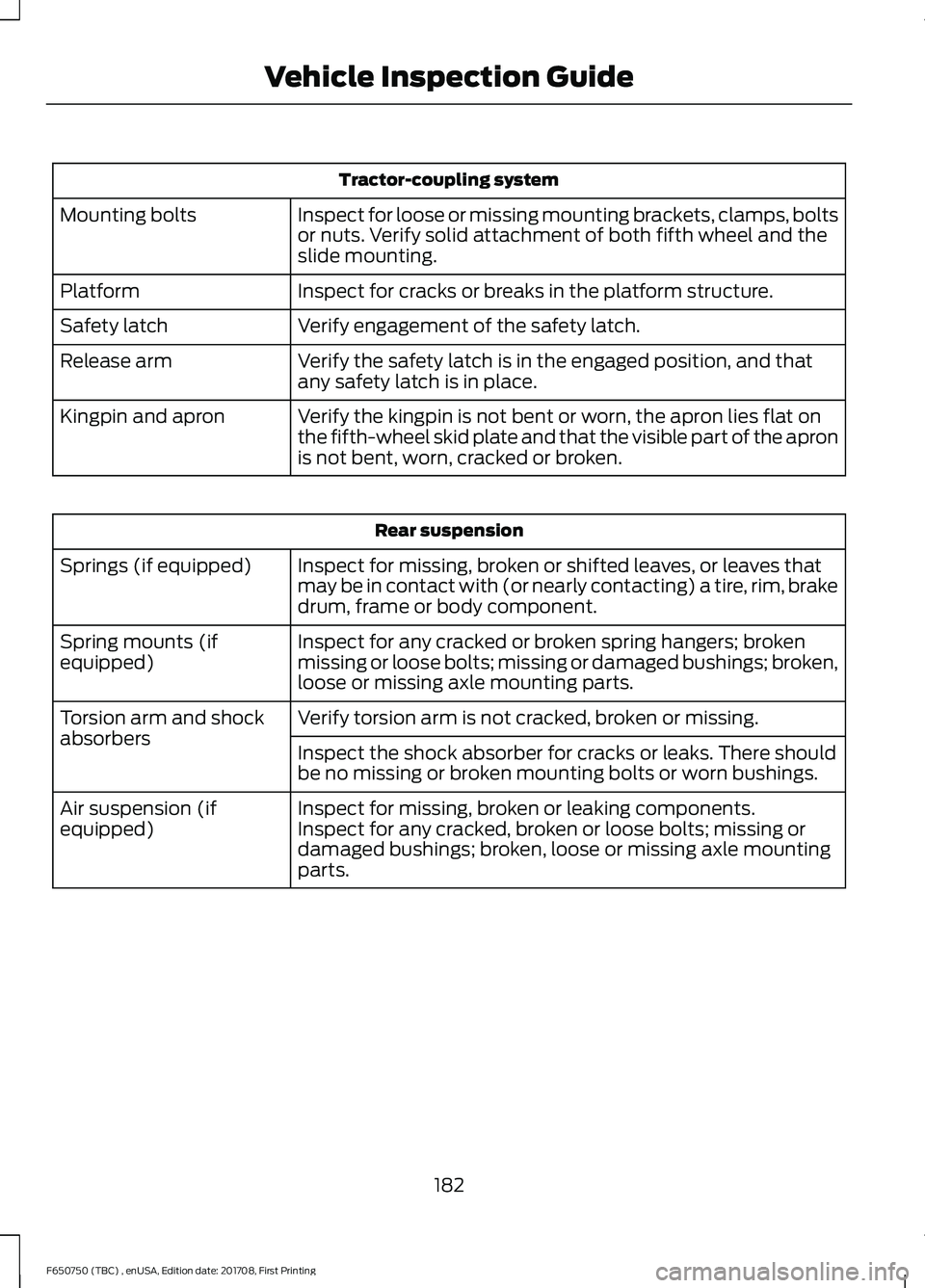
Tractor-coupling system
Inspect for loose or missing mounting brackets, clamps, bolts
or nuts. Verify solid attachment of both fifth wheel and the
slide mounting.
Mounting bolts
Inspect for cracks or breaks in the platform structure.
Platform
Verify engagement of the safety latch.
Safety latch
Verify the safety latch is in the engaged position, and that
any safety latch is in place.
Release arm
Verify the kingpin is not bent or worn, the apron lies flat on
the fifth-wheel skid plate and that the visible part of the apron
is not bent, worn, cracked or broken.
Kingpin and apron Rear suspension
Inspect for missing, broken or shifted leaves, or leaves that
may be in contact with (or nearly contacting) a tire, rim, brake
drum, frame or body component.
Springs (if equipped)
Inspect for any cracked or broken spring hangers; broken
missing or loose bolts; missing or damaged bushings; broken,
loose or missing axle mounting parts.
Spring mounts (if
equipped)
Verify torsion arm is not cracked, broken or missing.
Torsion arm and shock
absorbers
Inspect the shock absorber for cracks or leaks. There should
be no missing or broken mounting bolts or worn bushings.
Inspect for missing, broken or leaking components.
Air suspension (if
equipped) Inspect for any cracked, broken or loose bolts; missing or
damaged bushings; broken, loose or missing axle mounting
parts.
182
F650750 (TBC) , enUSA, Edition date: 201708, First Printing Vehicle Inspection Guide
Page 186 of 386
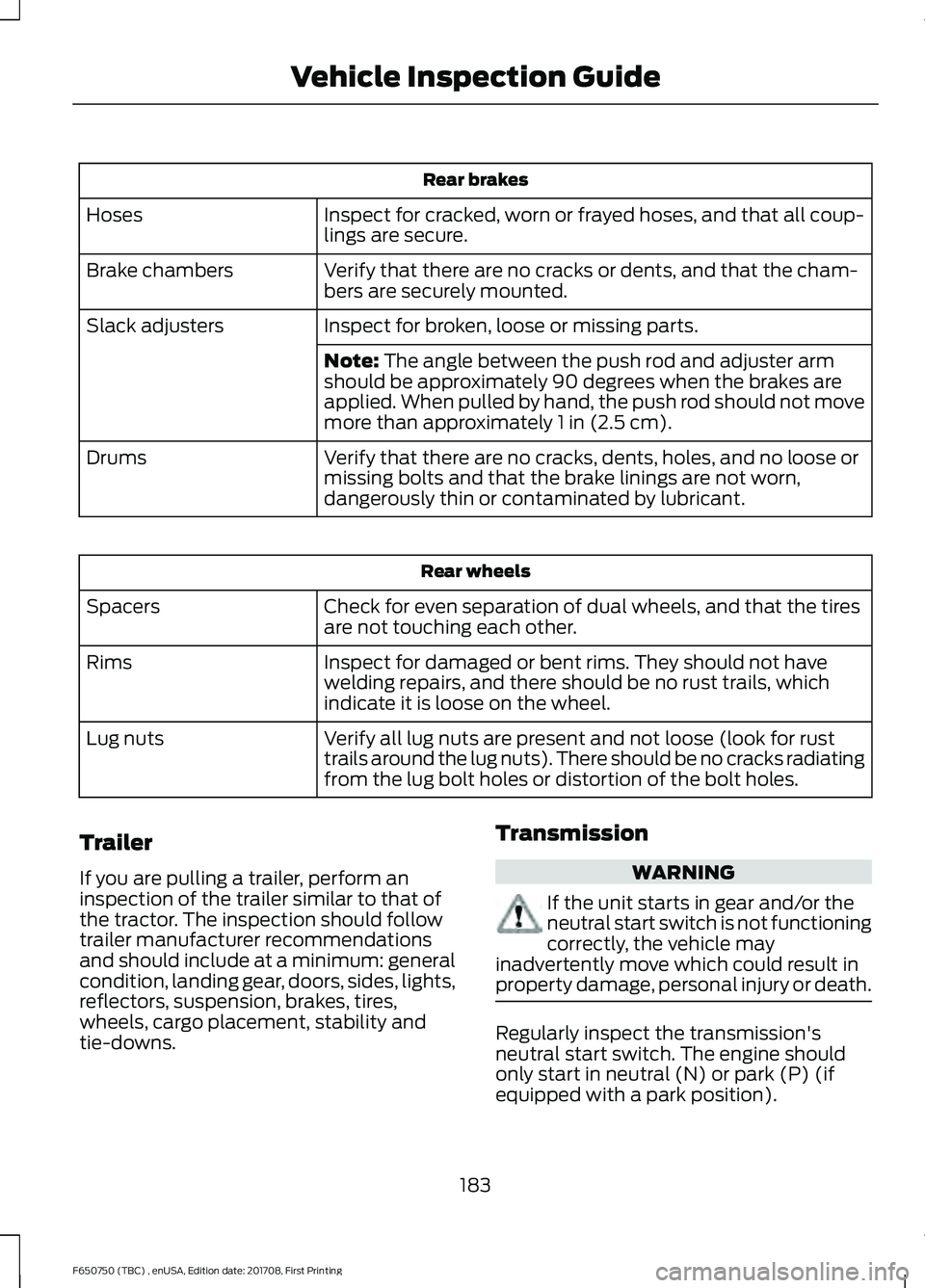
Rear brakes
Inspect for cracked, worn or frayed hoses, and that all coup-
lings are secure.
Hoses
Verify that there are no cracks or dents, and that the cham-
bers are securely mounted.
Brake chambers
Inspect for broken, loose or missing parts.
Slack adjusters
Note: The angle between the push rod and adjuster arm
should be approximately 90 degrees when the brakes are
applied. When pulled by hand, the push rod should not move
more than approximately
1 in (2.5 cm).
Verify that there are no cracks, dents, holes, and no loose or
missing bolts and that the brake linings are not worn,
dangerously thin or contaminated by lubricant.
Drums Rear wheels
Check for even separation of dual wheels, and that the tires
are not touching each other.
Spacers
Inspect for damaged or bent rims. They should not have
welding repairs, and there should be no rust trails, which
indicate it is loose on the wheel.
Rims
Verify all lug nuts are present and not loose (look for rust
trails around the lug nuts). There should be no cracks radiating
from the lug bolt holes or distortion of the bolt holes.
Lug nuts
Trailer
If you are pulling a trailer, perform an
inspection of the trailer similar to that of
the tractor. The inspection should follow
trailer manufacturer recommendations
and should include at a minimum: general
condition, landing gear, doors, sides, lights,
reflectors, suspension, brakes, tires,
wheels, cargo placement, stability and
tie-downs. Transmission WARNING
If the unit starts in gear and/or the
neutral start switch is not functioning
correctly, the vehicle may
inadvertently move which could result in
property damage, personal injury or death. Regularly inspect the transmission's
neutral start switch. The engine should
only start in neutral (N) or park (P) (if
equipped with a park position).
183
F650750 (TBC) , enUSA, Edition date: 201708, First Printing Vehicle Inspection Guide